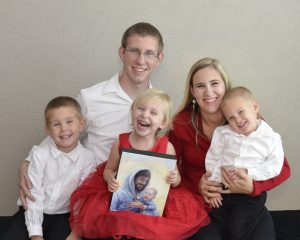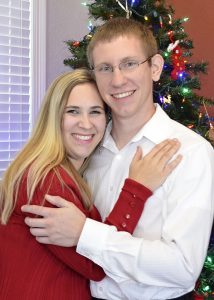Living with LCA: ‘It does no good to have pity’

Mikayla and Andrew Larson with Conner (L), Aubrie (holding painting of little brother Liam who passed away from SIDS) and Carter.
Mikayla Larson, a 30-year-old mother living with a rare inherited retinal disease (IRD) called Leber congenital amaurosis (LCA) wants to reassure children living with the same disease that they’re going to be OK.
“I feel that there are a lot of parents out there that are terrified for their kids to live this life,” she says from her southeastern Texas home. “And while it’s not ideal, it doesn’t mean that they aren’t capable of living a fulfilled life and love it like they should.”
Larson’s form of LCA, known as LCA6 caused by a mutation of the RPGRIP1 gene, is considered rare even within the realm of rare disease, accounting for only about 5 percent of the total LCA patient population. LCA in its more than two dozen genetic mutations affects fewer than 4,000 people in the United States; it accounts for 5 percent of all retinal dystrophies and 20 percent of blindness in school-age children.
Photoreceptors lacking RPGRIP1 are unable to maintain the retina’s light-sensing outer segments, resulting in patients losing retinal functions at an early age but retaining photoreceptors in the central retina well into adulthood, according to the National Institutes of Health.
Having grown up with vision loss, Larson says children born with LCA need the support of knowing that others have gone through life with the same inherited retinal disease and survived the bullying, mistreatment or embarrassment.
“I think I’d tell any parent that getting their child into therapy is a necessity,” she says. “Most of us need help navigating these very important emotional things in life. Like when you get made fun of, or when your sibling or friends get their driver’s license and you can’t. Just coping with what this will mean for their life and how to navigate it.”
Larson speaks from experience. More than anything, she wants to take the element of pity out of dealing with the disease.
“It does no good to have pity, or on the other side, to put people on a pedestal for doing things everyone can do,” she says. “It’s demeaning and degrading as a human to get praise for doing something everyone else can do, just because we can’t see well.”
She has some light perception and equates her field of vision to about the length of a drinking straw. With lenses, her visual acuity is 20/200 and 20/400.
Larson had vision loss early and began learning Braille at age 4. She was diagnosed at age 12, although incorrectly, with Retinitis Pigmentosa (RP). She worked with specialists to improve her independence but being around other kids never was easy. She was teased.
“You need extra help. You don’t want to stick out,” she recalls. “I made myself want to fly under the radar.”
By middle school, she didn’t want to deal with Braille or learn more about skills and concepts to help her get around and to be more independent.
“It was something that I just despised. I don’t want to be identified that way. I don’t want to be that kind of person.”
Larson did, however, go to Arizona State School for the Deaf and Blind in Tucson for her last two years of high school, graduating in 2007. She pursuing job training through the state’s Vocational Rehabilitation (VR) services, but the program lacked funding and was not accepting new clients.
While on the VR program waiting list in 2008, she met Andrew, who is now her husband, and in 2009 became pregnant with their first child.
They married in 2011, when their first-born, Conner, was 1. The day after the wedding, she was pregnant with her little girl, Aubrie. They lived outside of Phoenix and then moved even farther from family, southeast to a small Arizona town for Andrew’s first job as a chemical engineer.
The family moved in 2013 to another small town in southeastern Texas.
She is the mother of four children, “three here and one in heaven.” Their son Liam died from Sudden Infant Death Syndrome on April 3, 2015. He was 4 months old.
“My kids are very independent,” she says of 8-year-old Conner, 6-year-old Aubrie and Carter, 5. “They get up on their own with an alarm and get themselves dressed, and then Andrew and I make breakfast and make sure they have brushed teeth and are ready for school.”
Not being able to drive is a big deal, especially in rural Texas with no public transportation. Her children are picked up for school and driven home. Cooking has gotten easier and more comfortable with the advent of Air Fryers and Instant Pots.
Tripping over toys and three cats – Max, Teddy and Chester – is part of life. She shops with family and reads with the help of reading glasses and her phone’s camera, zooming in for small print.
“I would say I’m pretty self-reliant and just do what I need without any real thought.” She does suffer from anxiety.
“Once we lost Liam, the anxiety kind of crossed over into other parts of my life.” She is seeking help and open to resources.
Her biggest advocate, Andrew, contacted Spark Therapeutics, the developer of a new gene therapy called LUXTURNA™ for LCA2 (RPE65) because he thought she might have that form of LCA. The company suggested she receive genetic testing.
When Larson visited an ophthalmologist for a genetic testing referral, she was met with disbelief. The doctor said she couldn’t have LCA. “It’s too rare. That’s not possible,” he told her.
She finally got the doctor’s signature for testing, and, in January 2017 at age 28, her test revealed a mutation in her RPGRIP1 gene, also known as LCA6.
Larson says she was then in touch with Eric Pierce, MD and PhD, who is conducting lab-based research on RPGRIP1 at Massachusetts Eye and Ear. Dr. Pierce’s gene research involves evaluating the latest treatment version in a mouse model, with the plan to generate a gene-therapy vector for toxicology studies, ultimately leading to clinical trials.
While hopeful for a treatment, Larson prides herself on helping others and moving forward.
“We are still smart and capable. We have different challenges but that doesn’t mean we aren’t able.”

